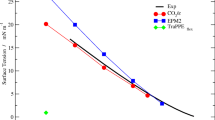Summary
-
1.
Accurate measurements of the dielectric coefficient ofcarbon dioxide have been made at 8 different temperatures from +20° to +210° C.
-
2.
The value of polarisation is constant within the limits of experimental error, indicating that the gas is non-polar within the temperature range employed.
-
3.
The results of the present investigations do not support the possibility of a bent structure for the molecule ofcarbon dioxide above 145° C., as postulated by Ibbs and Wakemann from their measurements on thermal diffusion and viscosity.
-
4.
Incidentally, accurate measurements of the dielectric coefficients ofmethane, have been made at four different temperatures in the range from +25° to +190° C.
Similar content being viewed by others
Explore related subjects
Discover the latest articles and news from researchers in related subjects, suggested using machine learning.References
Ibbs and Wakemann,Proc. Roy. Soc., (A), 1932,134, 613–42.
J. W. H. Lugg,Phil. Mag., 1929,8, 1019.
G. A. Elliott and I. Masson,Proc. Roy. Soc., (A), 1925,108, 378.
A. v. Obermeyer,Wien. Ber., 1875,71, 281.
P. v. Breitenbach,Ann. Phys. Chem., 1899,67, 803.
Trautz and Kurz,Ann. Physik., 1931,9, 983.
H. A. Stuart,Z. Physik., 1928,47, 457.
K. L. Ramaswamy,Curr. Sci., 1937,5, 152–53.
H. E. Watson, G. G. Rao and K. L. Ramaswamy,Proc. Roy. Soc., (A), 1931,132, 569–86;ibid. H. E. Watson, G. G. Rao and K. L. Ramaswamy,Proc. Roy. Soc., (A), 1934,143, 558–88.
Cawwood and Patterson,J. Chem. Soc., 1933, p. 619.
K. L. Ramaswamy,Proc. Ind. Acad. Sci., (A), 1935,4, 365.
H. Goldschmidt and P. Hölemann,Z. Physik. Chem., 1936,B32, 341–52.
McCrae,Proc. Camb. Phil. Soc., 1927,23, 890;ibid. Mc Crae,Proc. Camb. Phil. Soc., 1928,24, 290.
A. B. Van Cleave and O. Maass,Can. J. Research, 1935,13 B, 140–8.
Author information
Authors and Affiliations
Additional information
(Communicated by Sir C. V. Raman,kt., f.r.s., n.l.)
Rights and permissions
About this article
Cite this article
Ramaswamy, K.L. Dielectric polarisation and the form of the carbon dioxide molecule. Proc. Indian Acad. Sci. (Math. Sci.) 6, 301–311 (1937). https://doi.org/10.1007/BF03051253
Received:
Issue Date:
DOI: https://doi.org/10.1007/BF03051253




